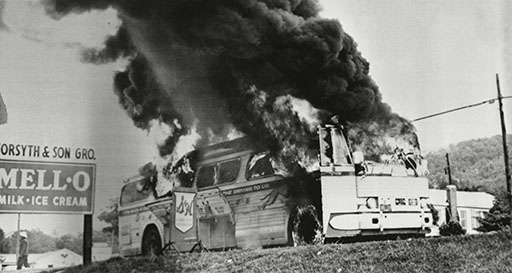4 The ‘Freedom Rides’
In 1961, civil rights activists once again captured national attention with what became known as the ‘Freedom Rides’. Segregation on interstate buses and at bus terminals had also been deemed unconstitutional by the Supreme Court, but the practice persisted in spite of this. In the first ‘Freedom Ride’, which began on 4 May 1961, groups of volunteers, organised by the Congress of Racial Equality (CORE), decided to protest against this by boarding buses in Washington D.C. and travelling through the South, bound for New Orleans, Louisiana. They sat wherever they wanted on the buses and attempted to use facilities that were reserved for White people. On 14 May, in Anniston, Alabama, White racists responded in brutal fashion, attacking the ‘Freedom Riders’ and firebombing one of the buses. The Alabama state police, meanwhile, failed to protect the activists. The violence attracted the attention of President John F. Kennedy, who thus far had been slow to act on civil rights issues. With the hope of quelling the unrest, Kennedy’s brother, Attorney General Robert F. Kennedy arranged for the riders to be escorted safely to Montgomery, Alabama. With further threats of violence, however, the riders eventually abandoned their journeys.
Following this, on 17 May 1961, the SNCC helped to revive the Freedom Rides, organising a new series of interstate bus journeys across the South. On 22 May, the Kennedy administration again had to intervene to ensure the safe passage of the riders to Jackson, Mississippi, where they were thrown in jail. Activists continued to travel on buses to Jackson over the subsequent days, and the jails began to overflow. Pressure from the Kennedy administration, and further Freedom Rides over the subsequent months, eventually forced the Interstate Commerce Commission (which regulated interstate bus transport) to enforce the desegregation of all interstate bus routes in September 1961.
The ‘Freedom Rides’ also succeeded in gaining widespread sympathy for the civil rights movement. As the historian M. J. Heale has explained, ‘the rides exposed the viciousness of southern white racism before the whole nation and seared the conscience of many citizens’ (Heale, 2001, p. 116). The vast majority of US households had televisions by 1960, and graphic images of racial brutality were beamed directly into American living rooms. Provoking violence and capturing media attention was therefore an important strategy for the civil rights activists. Television also added a global dimension to the civil rights protest, inspiring activists in other countries, including the United Kingdom.

